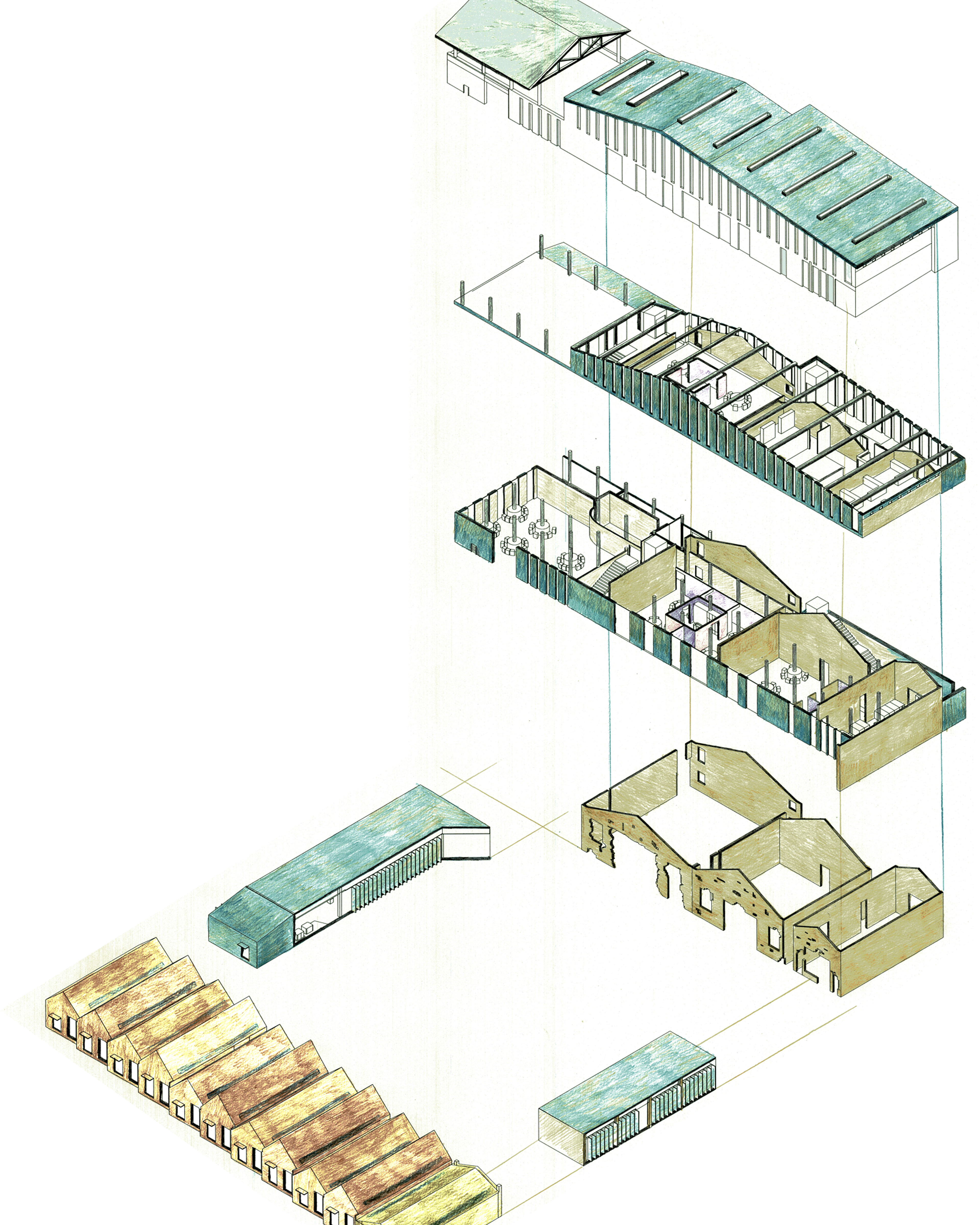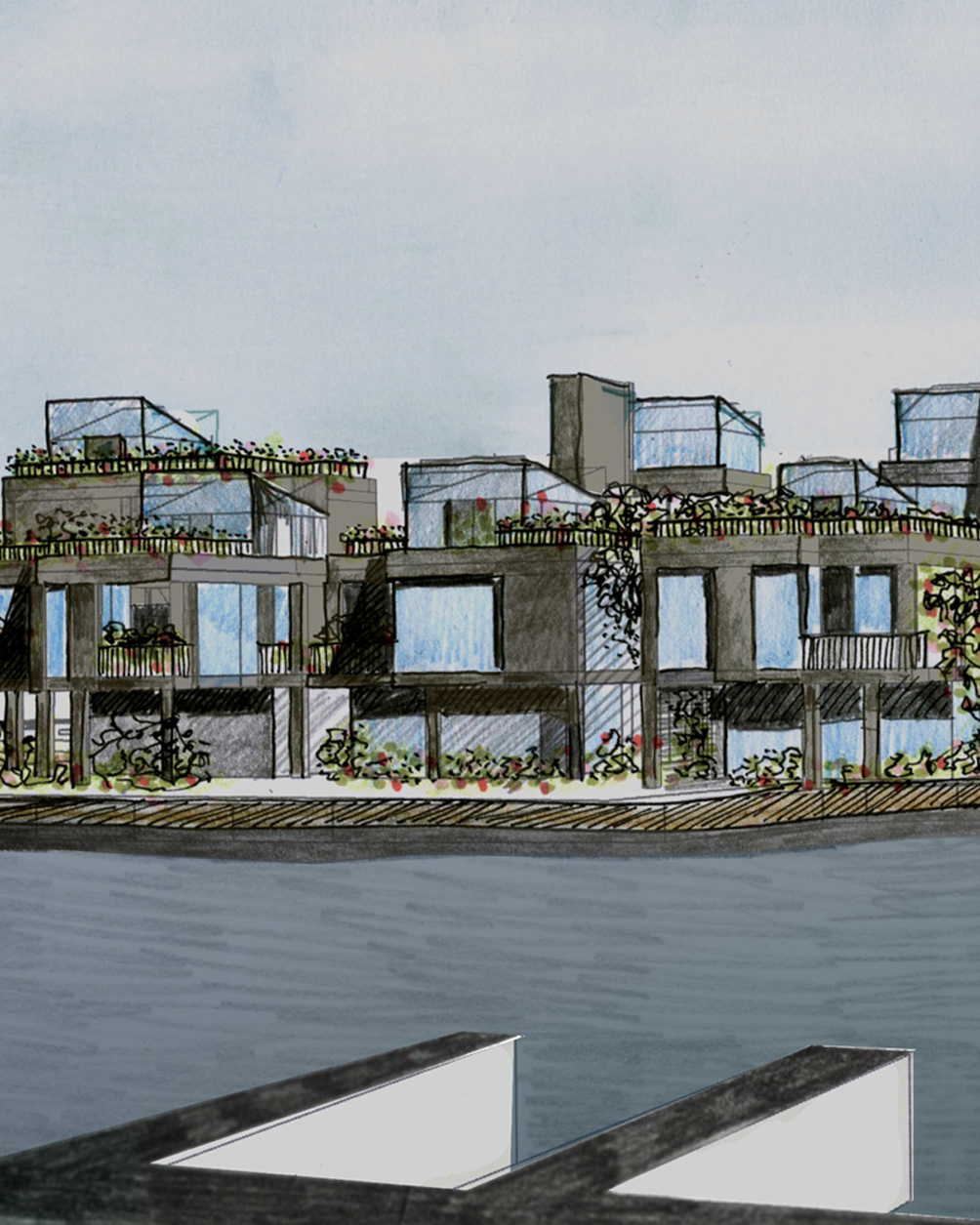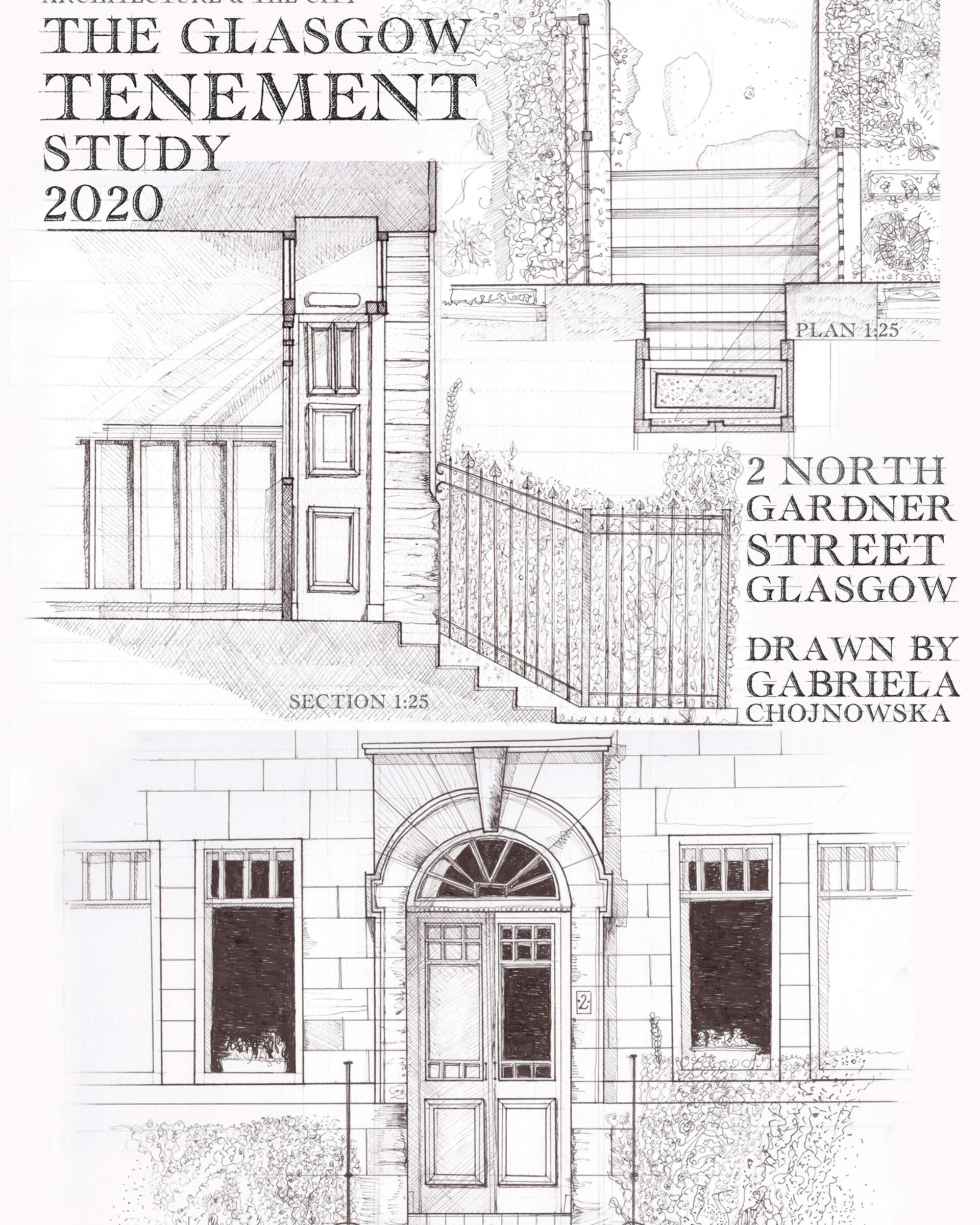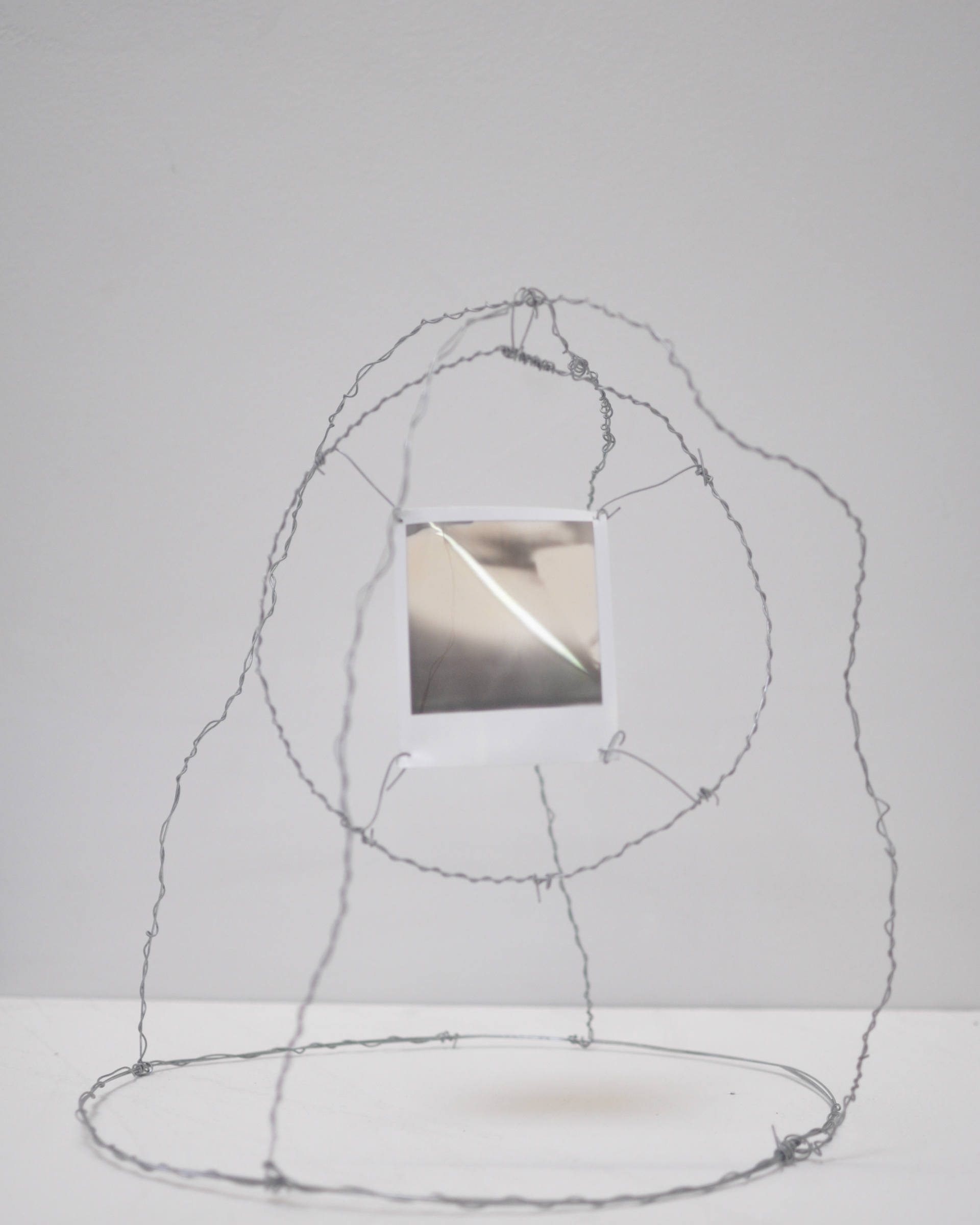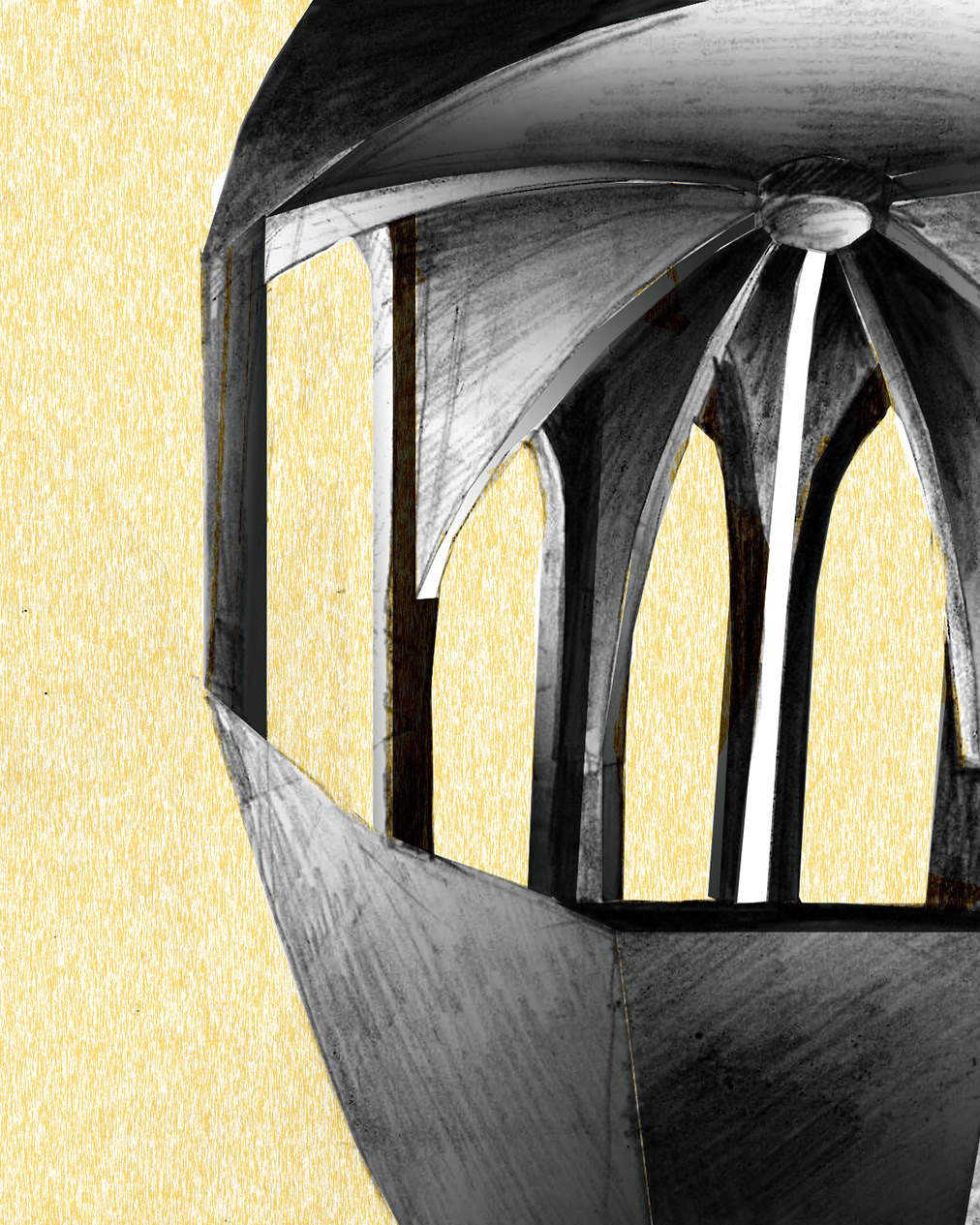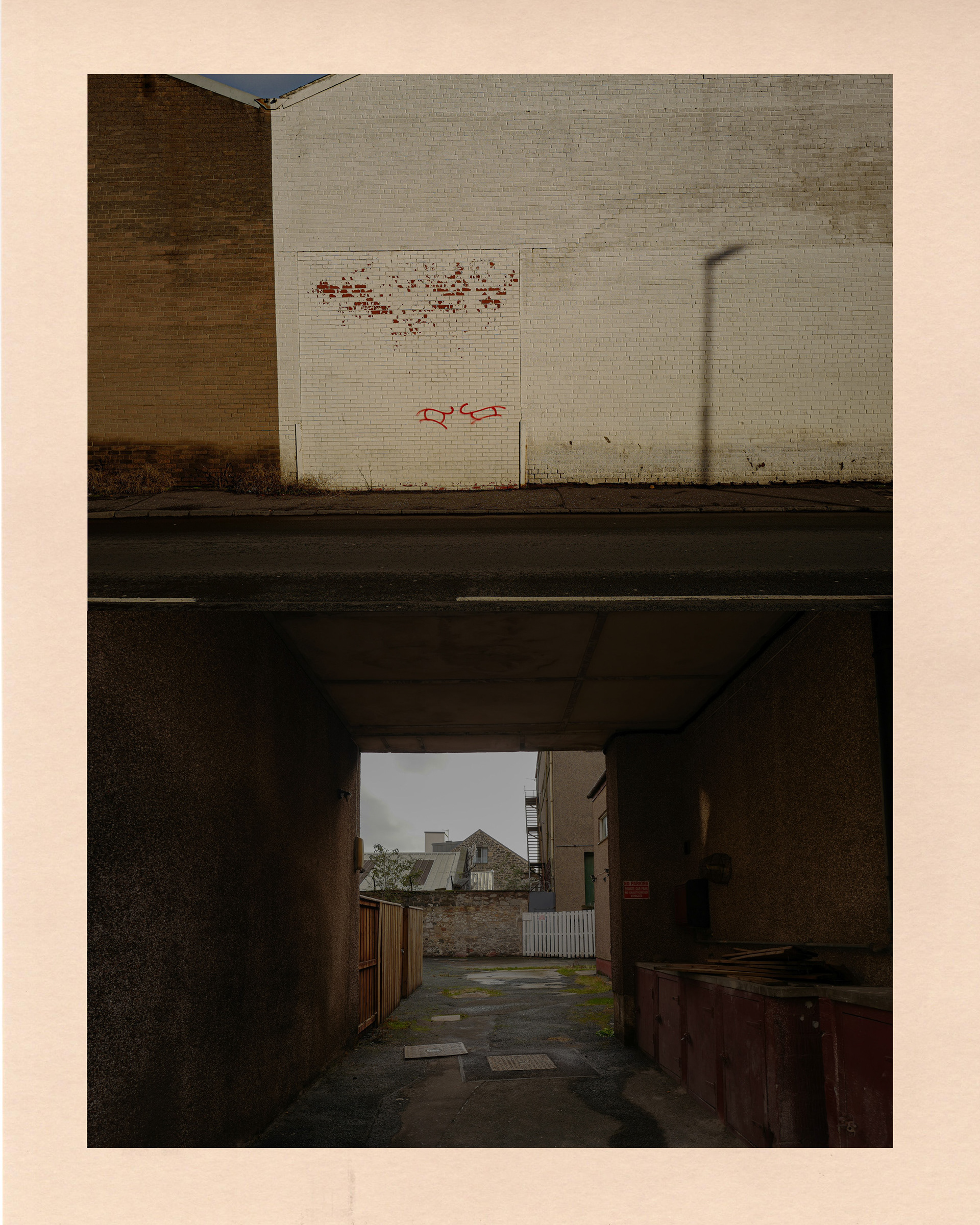01. Abstract
And we: onlookers, always, everywhere, always looking into, never out of, everything. It fills us. We arrange it. It collapses. We arrange it again, and collapse ourselves. - R.M. Rilke (fragment of the 8th Symphony)
Investigating spatial violence influences the understanding of a given site, its problems and its character.
I study the moment of danger of the Leith Docks site in Edinburgh. I made four visits to the docks to photograph, draw and engage in conversions with local people to document spatial violence occurring in the docks and its implications for the wider context of Leith.
The first part of the publication consists of initial explorations of the site. I study the changes in the coastline from the 18th century till the current times. To represent the moment of danger in the site, I capture the demolition of the Imperial Grain Silo through my drawings.
Building on the explorations, in the second part, problems of the site are identified. I discuss different forms of spatial violence - demolishing buildings, restricting access, lack of protection of the historic site, gentrification and capitalism.
In the third, concluding part, the port is re-imagined and possible solutions are discussed.
02. Introduction
Andrew Herscher and Anooradha Iyer Siddiqi defined ‘‘spatial violence’’ as ‘‘forms of harm mediated through the built environment (I). The authors highlight that the line between war and peace, rather than being a thick black line, would be better described as imaginary and fluent, always unsettled. Each action related to the built environment is connected with a frame of spatial violence.
In his book ‘‘Violence Taking Place’’, Herscher indicated that spatial violence does not always have to be negative and it does not have to stand in opposition to ‘‘culture’’. On contrary, violence can be a part of a culture and a means of communication (II).
In my study of spatial violence, I identify its different faces, by the means of researching the Port of Leith and its docks.
In chapter 1 the Port of Leith site and the Imperial Grain Silo building are introduced. The violence mediated through land extension and control is discussed. The next sections illustrate spatial violence as physical abuse in the process of demolition of the Imperial Grain Silo in the Leith Docks. The dismantling process of the building is documented and analysed through the series of drawings inspired by Riet Eeckhout and site photographs.
In chapter 2 we zoom out of the site to discuss the less obvious faces of spatial violence affecting the port. The discourse touches on the aesthetics of spatial violence, the aggression embodied in progress and modernisation and in gentrification. The spatial violence seen in the selective protection and conservation of heritage is examined and the role of capitalism in the violent acts is investigated.
In chapter 3, I use the collected information to reimagine the docks and present the site as compressed in time. Chapter 3 is an attempt to answer the question - how can we change the direction of the revolution? How can we learn from the moment of danger? The brief is formed in this section.
(I) Andrew Herscher & Anooradha Iyer Siddiqi (2014) Spatial Violence, Architectural Theory Review, 19:3, page 269, DOI: 10.1080/13264826.2014.1037538
(II) Andrew Herscher (2010) Violence Taking Place: The Architecture of the Kosovo Conflict, Stanford University Press, Stanford, California, page 4
(II) Andrew Herscher (2010) Violence Taking Place: The Architecture of the Kosovo Conflict, Stanford University Press, Stanford, California, page 4
Chapter 1: The Port of Leith and the Grain Silo
1.1 Background: the docks in Leith
Back in the 12th century, the original coastline was not further than the point, where the Water of Leith enters the sea - the site is still known as ‘the Shore’ nowadays (I). Leith is known to be one of the oldest seaports in the UK.
As presented on the historical maps (Fig. 01-05), since the 17th century the port has been expanding through additions of new wet and dry docks, the construction of tidal quays, and the creation of entrances and locks to the port (II). There is no doubt that the special character and feel we have in Leith today is largely influenced by its inclusion of the port, the docks and its history (III). The current plan of the docks is presented as a sketch (Fig. 06) and as an aerial view (Fig. 07).
Considering both the historic and aesthetic values of the site, it is striking to see the extent of inequality in the selective protection of the heritage. As it is the private land belonging to the Forth Ports, the access to docks is restricted and the dramatic performance is taking place unseen. What is concealed behind the fences is violence. Concealed and out of sight, the history of the port is being demolished by crusher machines, making space for a wind farm. Is tilting at windmills all that is left?
The situation brings to mind, what Andrew Herscher introduced as ‘‘warchitecture’’ - ‘‘blurring the line between the war and the architecture’’ (IV). The spatial violence in Leith and its docks takes multiple forms. The modernisation and development guided by capitalist mindsets are leading to the collapse of Leith’s spirit.
(I) The Royal Commission on the Ancient Monuments of Scotland (1951), ‘’An Inventory of Ancient and Historical Monuments of the City of Edinburgh with the Thirteenth Report of the Commission’’, page 255
(II) R.J. Godden, D.D. Land, P.A. Cox (1970) The Development of Leith Harbour, in Proceedings of the Institution of Civil Engineers Vol. 45 Issue 1, page 1
(III) Miles Tubb (2019) Leith Docks Editorial, Thelma Issue 15, The Living Memory Association, Edinburgh, page 3
(IV) Andrew Herscher (2008) Warchitectural Theory, Journal of Architectural Education, 61:3, page 35, DOI: 10.111/j.1531-314X.2007.00167.x
(II) R.J. Godden, D.D. Land, P.A. Cox (1970) The Development of Leith Harbour, in Proceedings of the Institution of Civil Engineers Vol. 45 Issue 1, page 1
(III) Miles Tubb (2019) Leith Docks Editorial, Thelma Issue 15, The Living Memory Association, Edinburgh, page 3
(IV) Andrew Herscher (2008) Warchitectural Theory, Journal of Architectural Education, 61:3, page 35, DOI: 10.111/j.1531-314X.2007.00167.x
1.2 Illustrating the time: manifestation of Violence
Figure 1: Leith Map from 1777
Note that all historic maps were accessed from the National Maps Library of Scotland
Note that all historic maps were accessed from the National Maps Library of Scotland
Figure 2 : Plan of Docks from 1822; Creation of East and West Dock, proposal of new wet dock to connect with the Newhaven Harbour
Note that all historic maps were accessed from the National Maps Library of Scotland
Note that all historic maps were accessed from the National Maps Library of Scotland
Figure 3: Plan of Docks from 1831; New East and West Piers - entrance to the dock is formed
Note that all historic maps were accessed from the National Maps Library of Scotland
Note that all historic maps were accessed from the National Maps Library of Scotland
Figure 4: Plan of Docks from 1862; Victoria Dock added, planned addition of Albert Dock and Edinburgh Dock
Note that all historic maps were accessed from the National Maps Library of Scotland
Note that all historic maps were accessed from the National Maps Library of Scotland
Figure 05: Plan of Docks from 1931; addition of Albert Dock, Edinburgh Dock and Imperial Dock
Note that all historic maps were accessed from the National Maps Library of Scotland
Note that all historic maps were accessed from the National Maps Library of Scotland
Figure 06: Sketch of the docks today, not to scale. Imperial Grain Silo marked in orange.
Figure 07: Google Maps view of the docks today (accessed from google maps on 13.11.2021)
As observed by Paul Virilio (I) people feel the necessity of domination. They want to control and expand the biggest territory possible. They want to ‘’scan it in all directions’’. He also notes that the division of the Earth was never fully defined and all the borders we create are only ephemeral aftermath of combat (II).
It could be interpreted that as long as we shape and transform the boundaries of lands, we are in a constant state of warfare.
Spatial violence can be observed in the creation of man-made borders such as fences, roads or trenches. It can be seen in expanding the land by building into the water. Rapaciousness can never be satisfied.
The fences and the fortifications created by people raise the
question: Who are we protecting and against whom?
question: Who are we protecting and against whom?
Illustrating the Time - how the coastline has been changing till the 1930s. (Fig. 8-9)
Through analysis of historical maps of the Port of Leith (Fig 01-05), I observed that the part of the docks, which today is a restricted access area was in majority created by people. The land of the port has expanded into the water since the 18th century. The land in discussion is therefore another human creation. Does it belong to those who built it? The artificially built land serves as a border, a thick line dividing the inhabitants from the waters of the sea.
(I) Paul Virilio (1994) Bunker Archeology, Princeton Architectural Press, Hudson, page 47
(II) Virilio, Bunker Archeology, page 27
(II) Virilio, Bunker Archeology, page 27
Figure 8: ‘’Illustrating the Time’’ A3 drawing on tracing paper, not to scale
Figure 9: ‘’Illustrating the Time’’ Series of digital drawings
1.3 Imperial Grain Silo
As part of my thesis, I observe the moment of the collapse of a building. The demolition of the grain silo in the Port of Leith is an allegory of revolution, reflection and redemption. The urgency to stop seeking redemption in demolition is the driver of my thesis.
Humans, as creators, think their creations belong to them forever (Fig. 17). We create borders and divide lands, sometimes with fences, other times with our actions. Through my photographs and drawings, I capture how the human feeling of rapaciousness is leading to the inescapable architectural death. In ‘‘Theses on History’’, Walter Benjamin indicates that the past is never safe (I). People seek redemption in their acts of destruction, inevitably making history a pile of rubble. The revolutionary moments break the linearity of time, revealing the fragments of the past to the future. In the study of demolition, it is possible to capture the explosion of time and to observe the vulnerability of the past toward the present.
Inspired by drawings by Riet Eeckhout (See Fig. 19 on page 26), I illustrate the moment of danger in Leith. Through recording the collapse of the Leith grain silo, I want to bring attention to the unequal treatment of the architecture of the past, gentrification, selective protection and the boundaries created by humanity.
(I) Walter Benjamin (1996) O Pojęciu Historii, in Eseje, Szkice, Fragmenty, Wydawnictwo Poznańskie, Poznań
1.4 The first impression: the carious tooth
The grain silo looked untouched from the port. The demolition was progressing at its back. A soundly looking structure (at the front), was slowly being torn apart where the eyes of the people could not even see it.
Spatial violence as physical violence: the process of demolition.
The study of the dismantling of the Imperial Grain Silo allowed me to see its design and structure in a clear form. As Herscher noticed the living energy of a building is neutralised when it undergoes destruction and one can clearly see its skeleton, its basic principles no longer alive, but ‘’haunted by meaning and culture’’. In the ‘’Theses on History’’, Walter Benjamin saw the collapse of a structure as a revolutionary moment, when time is compressed and one can see the complete history of the object. The past is known and the future is partially revealed to the present. Herscher noted that the act of destruction brings attention and meaning to the object under violence. The violated structure often becomes some kind of reification, a ‘’sign’’ of culture, a symbol of people it could potentially represent.
Inspired by drawings by Riet Eeckhout, I visited the demolition site four times and created a series of drawings recording its slow collapse.
1.5 Response I: the re-birth
The revolutionary moment of the demolition could be described as a moment, where the feeling of time collapses together with the building. We can see the full story compressed into ‘’now’’. We see the beginning. We see the ending. After the first visit to the Grain Silo, I wanted to look back to the beginning of its story.
The re-birth
1.6 Response II: the dialogue
Demolition is the most physical form of spatial violence.
The battle between the crusher machines and the building is the most obvious one. What is less noticeable, the battle of the past with the present and the future is happening at the same exact moment. Simultaneously, the building under demolition is violating itself. Some of its parts attack other fragments, bricks crush panes of glass, deformed steel parts pull down the next and all fall like dominoes.
The deconstructive process of tearing a building apart carry with it a silent story. Without the records, the story would remain untold forever.
I saw the demolition as a combat between the silo and the crushing machine. The crushing machine at work created a new unity with the building, a new form.
The crushing machine is another creation of humans and may be crushed by a similar one in future. Therefore, the image depicts a dialogue between two human creations possibly sharing the same fate.
The dialogue
1.7 Response III: the wrong impression
The wrong impression
1.8 Second Visit
The second visit took place on a busier day. The demolition was happening when I approached the silo. A man driving the crushing machines waved at me. I felt like watching a live performance. The dismantling was not spectacular, the machine was slowly biting the structure of the building. It looked like an animal feeding itself.
1.9 Response IV: feeding the animal
Feeding the animal
1.10 Response V: dismantling overlaid
1.11 Last visit
The fourth, and last visit was made possible due to the kindness of the crew of the SS explorer ship. The crew showed me around the docks. The conversations and their story made me realize the scale of the spatial violence taking place in the Leith docks.
Chapter 2: Dominoes - violence causes violence
2.1 The theatre of cruelty
‘’We cannot go on prostituting the idea of theatre whose only value is in its excruciating, magical relation to reality and danger’’(I).
The demolition and destruction of architecture can be seen as a reification of Artaud’s idea (II) of the theatre of cruelty. Looking at the stage – the space, where the act of violence takes place – we, the audience, see a scene almost surreal, but genuine in existence.
Forms of fascination toward warfare and violence had
already been revealed in history. Giovanni Papini stated that destruction refreshed humane creativity and wanted people to appreciate and love the war. Narratives like that of Papini ‘’raise the question of the relationship between violence as fantasy, as aesthetic violence, and real acts of violence’’ (III).
already been revealed in history. Giovanni Papini stated that destruction refreshed humane creativity and wanted people to appreciate and love the war. Narratives like that of Papini ‘’raise the question of the relationship between violence as fantasy, as aesthetic violence, and real acts of violence’’ (III).
A modernisation is also a form of violence. During the afterwar development, the acts of violence were often masked behind slogans advertising progress and a better future. It raises the question of how is violence concealed today. Destructive acts deepening the social and economical inequalities are hidden behind ‘’progress’’, ‘’fighting climate change’’ (greenwashing indeed) and ‘’heritage protection’’(IV).
(I) Antonin Artaud translated by Mary Caroline Richards (1958) The Theatre and Its Double, Grove Weidenfeld, New York
(II) The idea of the ‘‘Theatre of Cruelty’’ treats the audience as exposed participants to the play rather than protected viewers
(III) David Forgacs (1994) Fascism Violence and Modernity, in The Violent Muse: Violence and the Artistic Imagination in Europe, 1910-1939, Manchester University Press, NY
(IV) Herscher, Violence Taking Place, page 31
(II) The idea of the ‘‘Theatre of Cruelty’’ treats the audience as exposed participants to the play rather than protected viewers
(III) David Forgacs (1994) Fascism Violence and Modernity, in The Violent Muse: Violence and the Artistic Imagination in Europe, 1910-1939, Manchester University Press, NY
(IV) Herscher, Violence Taking Place, page 31
2.2 Response VI: the violent stage
The violent stage
2.3 Response VII: here or nowhere
Here or nowhere - drawing on A2
2.4 Spatial violence in gentrification
The other form of spatial violence observed in the example of the port of Leith is gentrification.
Gentrification is a less visible face of spatial violence because it is somewhat unintentional. Gentrification is a result of divisions amongst people and hence the lack of understanding of a context, to which one does not belong. It can also be a result of detachment from the land. It is violent to displace people and wipe out the history and character of their homes. It was violent from the beginning when people conquered the Earth and gentrified homes of multiple species to cover the land in concrete and asphalt.
2.5 Spatial violence in selective protection of heritage
Spatial violence can be seen in the selective protection of historical sites and buildings. How do we decide what is meant to be called heritage?
At the beginning of the 20th century, Riegl brought up the idea of ‘’Kunstwollen’’ suggesting that each building was made with some purpose and motivation even if we do not recognize these in the present. He divided the values of an artefact into historic values, which represented a step in time and actuality values representing the aesthetic ideals of an observer (I). The actuality values are not constant.
Why do we preserve a 150-years old governmental building in the city centre and decide to collapse 100-year-old grain silos, which can be read as icons, telling the story of the port? Do we find them ugly? How do we know that our actuality values are more precious than someone else’s, living in a different time?
(I) A. Riegl (1903) Der modern Denkmalkultus, sein Wesen und seine Entstehung, in Price N.S., Talley K.M., Melucco Vaccaro A. (1996) Historical and Philosophical Issues in the Conservation of Cultural Heritage’’, Los Angeles: The Getty Conservation Institute
2.6 Response VIII: silent war
Silent war
2.7 Dominoes: the capitalist mindset
Andrew Herscher noticed that ‘’architectural damage and destructions are posed not as threats to social order, but as attempts to impose novel forms of order through the production of place’’ (I). New places are made on the graveyards of the old sites and it is named ‘’progress’’.
On the other end, Virilio described the expansion of war to the limits of reality saying ‘’as destruction becomes a form of production’’. Do we destroy to build or do we build to destroy and continue the never-ending expansion? (II)
In modern times, architects were convinced that progress is the highest priority (III). People felt the necessity to break the connection with the past. Futurists, in their manifesto, proposed the demolition of historical libraries and museums. They wanted to feel the ‘’speed’’ and ‘’sing the song of danger’’. Spatial violence was a sign of a new, better future (IV).
Le Corbusier suggested architecture can stop political aggression and hence the violent revolution. He proposed that architecture could be revolutionary, changing people's mindsets (V).
Modern dreams and imaginary predictions quickly came down to Earth. Herscher boldly stated that ‘’modernization was a war’’(VI). Another profile of spatial violence comes into view. Inequality generated by capitalism. After the 1970s the role of architecture changed more to means of revenue. The architecture was commercialised (VII).
Herscher and Iyer Siddiqi noted that the violence, which is systematically manifested through domination and exploitation is less visible than the physical destruction, however, the capitalist values are often creating an environment ideal for accommodating violence and they are acting ‘’as a buttress against violent forms’’(VIII).
Capitalist mindset is often the pushing of a first domino block in the row. The violence that creates other violence. Commodity fetishism starts the chain reaction and provokes inequalities, gentrification, and destruction. The latest is understood both in terms of demolition under the slogan of illusionary ‘’progressing’’ and/or as Herscher named it, as ‘’warchitecture’’, the destruction as means of showing the otherwise unfelt presence of opposition (IX).
(I) Herscher, Violence Taking Place, page 41
(II) Virilio, Bunker Archeology, page 58
(III) Reinier De Graaf (2015) Architecture is now a tool of capital, complicit in a purpose antithetical to its social mission, the Architectural Review
(IV) Filippo Tommaso Marinetti (2016) The Futurist Manifesto, Passerino Editore
(V) Le Corbusier (1986) Towards a New Architecture, Dover Publications Inc, Mineola, page 279
(VI) Herscher, Violence Taking Place, page 42
(VII) Reinier De Graaf (2015)
(VIII) Herscher and Iyer Siddiqi, Spatial Violence, page 272
(IX) Herscher, Violence Taking Place, page 42
(II) Virilio, Bunker Archeology, page 58
(III) Reinier De Graaf (2015) Architecture is now a tool of capital, complicit in a purpose antithetical to its social mission, the Architectural Review
(IV) Filippo Tommaso Marinetti (2016) The Futurist Manifesto, Passerino Editore
(V) Le Corbusier (1986) Towards a New Architecture, Dover Publications Inc, Mineola, page 279
(VI) Herscher, Violence Taking Place, page 42
(VII) Reinier De Graaf (2015)
(VIII) Herscher and Iyer Siddiqi, Spatial Violence, page 272
(IX) Herscher, Violence Taking Place, page 42
Chapter 3: how can we redirect the revolution?
3.1 The saving power
Herscher and Iyer Siddiqi noted that the timeline of historic events and the timeline of spatial violence are independent of each other, but we can observe some interrelations (I). Military conflict is often connected with excessive spatial violence, especially its physical face.
How can we know where is the limit of the normal level of spatial violence?
In chapters 1 and 2, through multiple examples, I demonstrated the seriousness of the warchitecture (II) happening in the Docks of Leith, in Edinburgh.
‘‘But where the danger is, there also rises the saving power’’ - F.Holderin (III)
In Chapter 3, I re-imagine the docks, layering the information collected throughout my research to record the history and think of how can We redirect the revolution.
(I) Herscher and Iyer Siddiqi (2014) Spatial Violence page 271
(II) Term introduced by Herscher
(III) Friedrich Hölderlin Patmos translated by David Constantine (1991) Selected Poems, Bloodaxe Bookx, page 54
(II) Term introduced by Herscher
(III) Friedrich Hölderlin Patmos translated by David Constantine (1991) Selected Poems, Bloodaxe Bookx, page 54
3.2 The time is compressed
4.0 Conclusion
I studied the moment of danger of the Port of Leith and its docks in Edinburgh through photography, analysis of historical maps, site visits, drawings and conversations.
Forms of spatial violence affecting the site were discussed and illustrated. The violence mediated through land extension was depicted through the study and overlaying of the historical maps. The spatial violence in the process of demolition was presented as an example of the current dismantling of the Imperial Grain Silo building. The destruction was documented through a series of drawings inspired by the works of Riet Eeckhout.
The aesthetics of spatial violence, the aggression embodied in progress and modernisation, gentrification and selective protection and conservation of heritage were considered. The role of capitalism in violent acts was discussed. All the above issues were illustrated in a series of drawings and photographs.
The study of spatial violence allowed me to understand the history, the character and the problems of the chosen site. In the final drawing entitled ‘‘Compressing the Time’’, I present the collection of knowledge I gathered in one image. The research allowed me to re-think the Port and the spatial violence it experiences. In my opinion, the spatial aggression in the port is exceeding acceptable norms and an intervention is needed to bring back the balance. I challenge myself to re-design the dockyard’s master plan and create a place for the people of Leith and Edinburgh, where the special character and story of their homeland are preserved.

